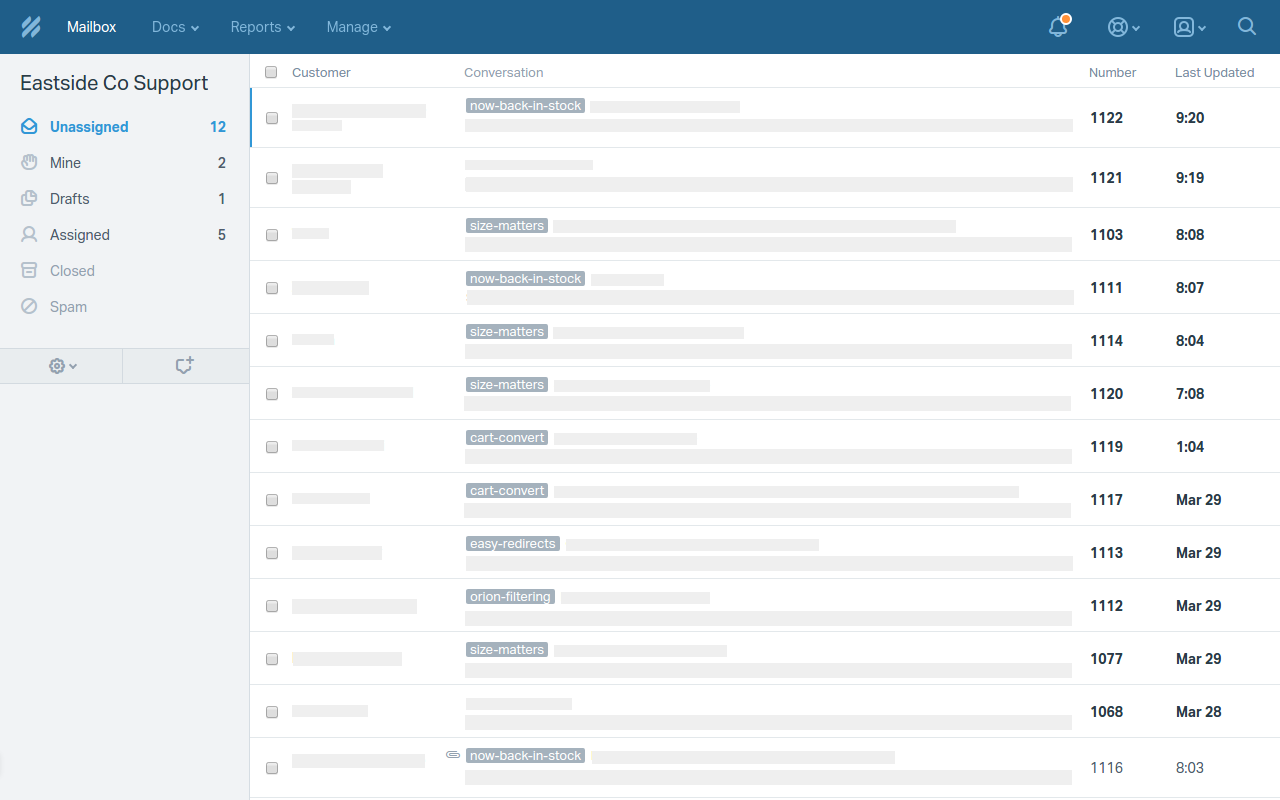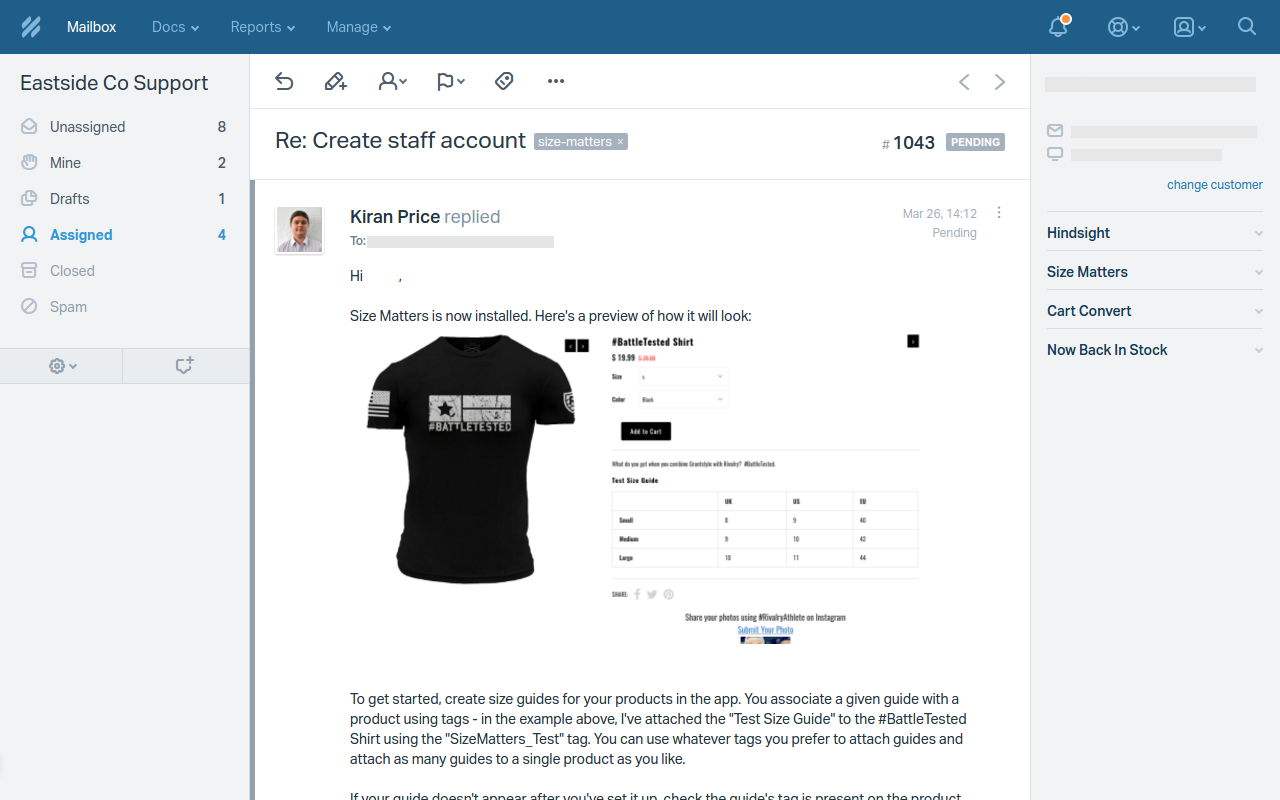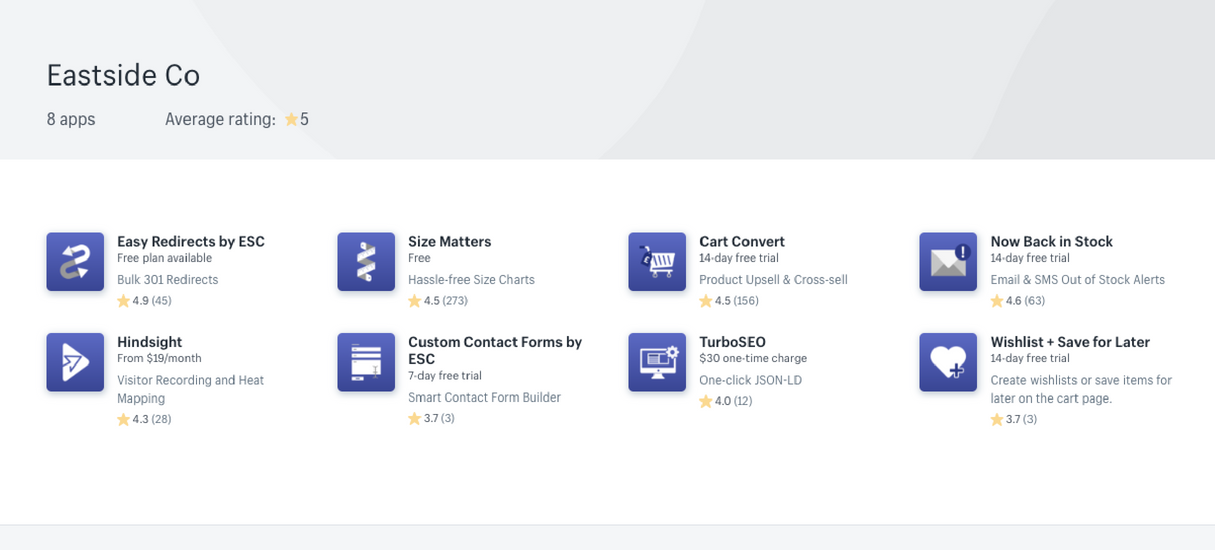Setting up an effective support process is crucial to every app developer’s success, and it's critical that you get it right—especially in times of heightened traffic, such as Black Friday Cyber Monday (BFCM) and other holiday shopping seasons.
Poor support reflects badly on the rest of your offerings—no matter how good a product you build, poor response times or unfriendly replies can destroy your reputation faster than anything else.
A good support process will improve user retention, lead to better reviews, and encourage your apps to grow and gain the recognition they deserve.
A good support process will improve user retention, lead to better reviews, and encourage your apps to grow and gain the recognition they deserve.
Today, we’ll guide you through how to improve your app’s support services, and why offering stellar support makes all the difference to your bottom line.
How we improved our support process
At Eastside Co., we support eight applications in the Shopify App Store. Having multiple apps that serve several different merchant types, we’ve come to understand through first-hand experience how providing quality support is crucial to growing an app business. Here are a few strategies we’ve used to improve our support process.
1. Help customers find solutions on their own
Wherever possible, we reduce the need for customers to contact us for support. Although we will provide the best support if needed, the fact they had to contact us could mean something has gone wrong, and our apps aren’t as user-friendly and clear as we desired.
Have a look at our checklist below to make sure you’re giving your users as much information as possible so they can help themselves:
-
Write documentation. No one likes writing it, but good technical documentation is the best way to avoid unnecessary or repetitive requests. Depending on the complexity of your app, this could be an FAQ page, or a full, multi-page manual. Make sure your docs are prominently linked to inside your app so that they are easy to find.
-
Preempt common issues. If you’re getting frequent enquiries about a single issue, consider adding a paragraph under ‘hint’ in your app’s UI, near where users keep running into it.
- Tell users how to contact you clearly, and often. When all else fails, having your email address or support URL clearly linked within your app may be the difference between a slightly annoyed email, and a poor review. Make it clear how users can contact you for help.
If your app has an installation step, consider doing the following to avoid uninstalls:
-
Have installation instructions inside your app. As soon as your app is opened, show clear, step-by-step instructions.
-
Provide a way to get back to the instructions. In their excitement to use your app for the first time, users might end up skipping past your instructions. Always provide a way to review them so that users don’t need to contact you for help.
- Perform a verification step (if possible). If your app requires inserting Liquid or HTML, consider adding an automated step that grabs the page and checks it’s been added. This can tip users off to common mistakes and avoid frustration.
You might also like: How to Improve Your Shopify App's Onboarding Flow.
2. Develop a more organized support structure
When we set up our first app, we had a single shared inbox for support. Once or twice a day, someone would log in, respond to emails, and fulfill support requests.
While this works in the short term, we very quickly found some major disadvantages to working like this:
-
Keeping track of threads is hard. Properly handling a single support request usually requires a few emails back and forth, and email isn’t the greatest for quickly catching up on a thread, especially when many requests are very similar.
-
It doesn’t scale. Although it won’t be a problem to start with, you’ll eventually want to have more than one person handling support requests. A shared inbox sets you up for some fairly confusing (and sometimes embarrassing) moments when you’re unable to keep track of who’s meant to be working on what.
- You can’t get to know your users. Users who need support once will often come back again in the future, whether as a follow-up to the same issue or something unrelated. Being able to keep track of which user owns which site, and what you’ve discussed in the past, is crucial to providing the best experience and to avoiding wasted time.

We solved these issues by moving to a helpdesk platform. A good helpdesk solution will:
-
Still have a single point-of-contact for your customers. Ours allowed us to keep using our support@eastsideco.com address as the point-of-contact for all our enquiries.
-
Keep track of threads and customer information. A good helpdesk will provide simple threads, let you add notes, and see what you’ve discussed in the past.
- Assign and manage requests. If you have multiple people handling support, a helpdesk will let you assign threads, and alert you if two agents are trying to reply at once—avoiding those embarrassing mistakes I mentioned earlier.
We’ve been using Help Scout for our support enquiries due to its ease-of-use and extensibility. We particularly liked how we could use our development resources to optimize our support process, by using their API to show customer store information and subscription details directly within support threads.
There are a whole load of support solutions out there, including Zendesk and Salesforce. Finding one that fits your workflow and budget can be one of the most worthwhile investments you make in your support process.
You might also like: Customer Empathy in Overdrive: Rewind’s 3 Principles for a Successful App Business.
3. Crafting the best support experience

We’ve spent a while trying to figure out how to provide our users with the best support process possible. We’re not perfect, but we like to think we’re always improving.
We’ve spent a while trying to figure out how to provide our users with the best support process possible. We’re not perfect, but we like to think we’re always improving.
Here are some things we’ve learned about actually responding to support requests that may help other app developers:
-
Be friendly. Shopify is a pretty friendly platform, and we really like how approachable and readable their docs and support are. We’ve had the best responses when we try to emulate this as much as possible—by focusing on being approachable and pragmatic, and avoiding sounding too corporate or technical.
-
Be proactive in dealing with issues and contacting users. Occasionally, we mess up or discover a bug that’s been affecting our users. It’s a good idea to figure out who it has affected, and to get in touch, even if it’s a cursory email explaining that they may have seen some issues and that everything is resolved. If they notice, it puts their mind at rest and avoids a support enquiry—if not, you at least look accountable and honest.
-
Use media when things get complicated. When asking a user to do something more complex, consider illustrating what you mean with a screenshot or short video. Simple illustrations avoid a lot of confusion and can avoid a lot of back-and-forth.
- Take advantage of the resources provided by Shopify. Link to the Shopify docs rather than explaining core Shopify features. Use collaborator accounts to quickly request access to someone’s store.
You might also like: 9 Pro Tips to Create a Stellar App Customer Experience.
How improving support affected Eastside Co.

So, how does any of this help us as app developers? Why bother optimizing your support process over adding features?
It helps you get good reviews. App store review ratings are currently the only marker that Shopify provides for app quality — and maintaining a good rating is critical to any app. We’ve found that the quality of our support is this single most important factor in how well our apps are reviewed.
Support acts like a filter on your review score: no matter how good your app is, your ratings will always be capped if there’s a percentage of users who struggle to use it or who are dissatisfied with the response from your support process.
While having a good support process doesn’t guarantee shining five-star reviews, it avoids all those reviews where users couldn’t even get started with your app. And if your support is really good, it also gives them something nice to compliment you on in their review.
While having a good support process doesn’t guarantee shining five-star reviews, it avoids all those reviews where users couldn’t even get started with your app.
It helps you learn more about your users. Many of the features that have made it into our apps wouldn’t be there if we didn’t spend as much time helping and talking to users. Merchants can be very vocal about what they want when given the opportunity, and developers can take advantage of that by focusing on features they know people want.
For example, one of our apps creates size charts for different products, and when one of our clients needed to replicate very similar size charts for a huge variety of products, we created a ‘clone’ option to make this process quick and straightforward. It not only delighted a client in need, but helped us add a feature we might not have considered otherwise.
It helps better your reputation and branding. Merchants learn to recognize and prefer apps by the developers they trust. Just as a user might learn to associate a developer’s branding with ease-of-use, useful tools, or reliability, a user who associates your branding with a pleasant support experience is more likely to investigate your other apps when they see them in the app store.
You might also like: How to Get Reviews for Your Shopify Apps .
Support is important to Shopify
We’ve been piecing together our app support process over the past years, as we’ve released new apps and grown our team. While we still have a lot to work on, I hope we’ve been able to give other developers some useful tips for getting started.
Ease-of-use and quality of support have always been massively important to Shopify, and it’s important that all developers in this ecosystem work on this aspect of their products as well.
Read more
- How to Brand Your Shopify App to Earn More in the App Store
- App UX Design In 2021: What You Need to Consider
- 6 Phases of the App Development Process: From Idea to Post-Launch
- 5 Community-Built API Tools Developers Should Check Out
- How to Use Future Scenario Planning in App Development
- Shopify Marketing: How and Why You Should Integrate Your App
- 10 Podcasts for Exploring Machine Learning
- Free Webinar] Building Great App User Interfaces with Polaris
- Use the Kit Skills App Extension to Engage Your Users Conversationally
- How We Built Out Our Reporting Dashboard with Shopify Polaris
What tools or methods have you found useful in providing customer support for apps? Let us know in the comments below.




